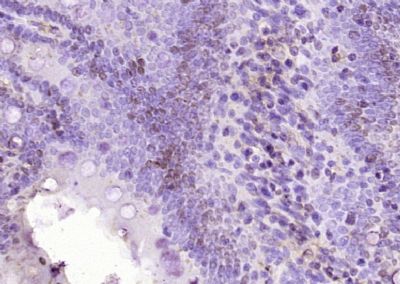FAM84A Polyclonal Antibody
Purified Rabbit Polyclonal Antibody (Pab)
- SPECIFICATION
- CITATIONS
- PROTOCOLS
- BACKGROUND

Application
| WB, IHC-P, IHC-F, IF, ICC, E |
|---|---|
| Primary Accession | Q96KN4 |
| Reactivity | Rat, Pig, Dog, Bovine |
| Host | Rabbit |
| Clonality | Polyclonal |
| Calculated MW | 32 KDa |
| Physical State | Liquid |
| Immunogen | KLH conjugated synthetic peptide derived from human NSE1/FAM84A |
| Epitope Specificity | 151-250/292 |
| Isotype | IgG |
| Purity | affinity purified by Protein A |
| Buffer | 0.01M TBS (pH7.4) with 1% BSA, 0.02% Proclin300 and 50% Glycerol. |
| SIMILARITY | Belongs to the FAM84 family. |
| Post-translational modifications | Isoform 2 is phosphorylated. |
| Important Note | This product as supplied is intended for research use only, not for use in human, therapeutic or diagnostic applications. |
| Background Descriptions | FAM84A is a 292 amino acid protein that belongs to the FAM84 family of proteins. Predominantly expressed in testis, FAM84A shares 44% amino acid identity with the related protein FAM84B. FAM84A localizes to a subcellular membrane region where there is no contact between neighboring cells and is believed to play a role in cell morphology and motility. More specifically, the expression of FAM84A increases cell motility. Two FAM84A isoforms are expressed due to alternative splicing events. Isoform 2 can be phosphorylated on various serine residues and this phosphorylation is associated with cellular morphology. FAM84A is upregulated in colorectal cancer, lung cancer, pancreatic cancer, cholangiocarcinoma and bladder cancer tissues. Via its ability to increase cell motility, FAM84A may contribute to the invasion and metastasis of cancer cells. |
| Gene ID | 151354 |
|---|---|
| Other Names | Protein LRATD1, LRAT domain-containing 1 {ECO:0000312|HGNC:HGNC:20743}, Neurologic sensory protein 1, NSE1, Protein FAM84A, LRATD1 (HGNC:20743), FAM84A, NSE1 |
| Dilution | WB=1:500-2000,IHC-P=1:100-500,IHC-F=1:100-500,ICC=1:100-500,IF=1:100-500,ELISA=1:5000-10000 |
| Storage | Store at -20 ℃ for one year. Avoid repeated freeze/thaw cycles. When reconstituted in sterile pH 7.4 0.01M PBS or diluent of antibody the antibody is stable for at least two weeks at 2-4 ℃. |
| Name | LRATD1 (HGNC:20743) |
|---|---|
| Synonyms | FAM84A, NSE1 |
| Function | May play a role in cell morphology and motility. |
| Cellular Location | Cytoplasm. |
| Tissue Location | Only detected in testis. Highly expressed in colon cancer cells. |

Thousands of laboratories across the world have published research that depended on the performance of antibodies from Abcepta to advance their research. Check out links to articles that cite our products in major peer-reviewed journals, organized by research category.
info@abcepta.com, and receive a free "I Love Antibodies" mug.
Provided below are standard protocols that you may find useful for product applications.
If you have used an Abcepta product and would like to share how it has performed, please click on the "Submit Review" button and provide the requested information. Our staff will examine and post your review and contact you if needed.
If you have any additional inquiries please email technical services at tech@abcepta.com.













 Foundational characteristics of cancer include proliferation, angiogenesis, migration, evasion of apoptosis, and cellular immortality. Find key markers for these cellular processes and antibodies to detect them.
Foundational characteristics of cancer include proliferation, angiogenesis, migration, evasion of apoptosis, and cellular immortality. Find key markers for these cellular processes and antibodies to detect them. The SUMOplot™ Analysis Program predicts and scores sumoylation sites in your protein. SUMOylation is a post-translational modification involved in various cellular processes, such as nuclear-cytosolic transport, transcriptional regulation, apoptosis, protein stability, response to stress, and progression through the cell cycle.
The SUMOplot™ Analysis Program predicts and scores sumoylation sites in your protein. SUMOylation is a post-translational modification involved in various cellular processes, such as nuclear-cytosolic transport, transcriptional regulation, apoptosis, protein stability, response to stress, and progression through the cell cycle. The Autophagy Receptor Motif Plotter predicts and scores autophagy receptor binding sites in your protein. Identifying proteins connected to this pathway is critical to understanding the role of autophagy in physiological as well as pathological processes such as development, differentiation, neurodegenerative diseases, stress, infection, and cancer.
The Autophagy Receptor Motif Plotter predicts and scores autophagy receptor binding sites in your protein. Identifying proteins connected to this pathway is critical to understanding the role of autophagy in physiological as well as pathological processes such as development, differentiation, neurodegenerative diseases, stress, infection, and cancer.


